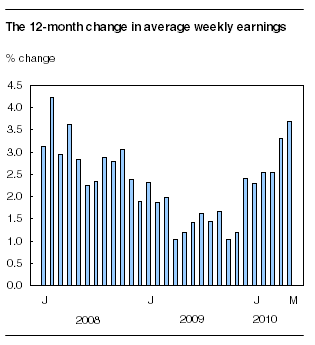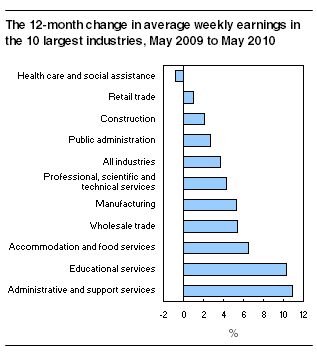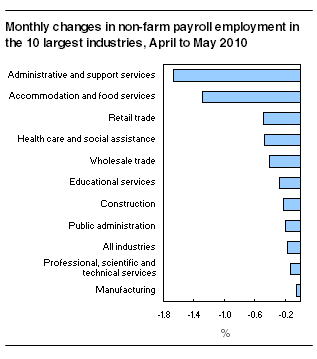Common menu bar links
Payroll employment, earnings and hours
Archived Content
Information identified as archived is provided for reference, research or recordkeeping purposes. It is not subject to the Government of Canada Web Standards and has not been altered or updated since it was archived. Please "contact us" to request a format other than those available.
Related subjects
In May, average weekly earnings of non-farm payroll employees rose by 3.7% from May 2009 to $848.45. This was the fastest year-over-year increase since February 2008.

In recent months, the pace of growth in earnings has increased. May marked the sixth consecutive month for which the year-over-year increase was at or above 2.3%. During the prior eight months, year-over-year increases were below 1.8%.
Note to readers
The Survey of Employment, Payrolls and Hours (SEPH) is a business census of non-farm payroll employees. Its key objective is to provide a monthly portrait of the level of earnings, the number of jobs and hours worked by detailed industry at the national, provincial and territorial level.
Statistics Canada also produces employment estimates from its monthly Labour Force Survey (LFS). The LFS is a household survey whose main objective is to divide the working-age population into three mutually exclusive classifications: the employed (including the self-employed), unemployed and not in the labour force. This survey is the official source for the unemployment rate and collects data on the socio-demographic characteristics of all those in the labour market.
Unless otherwise stated, this release presents seasonally adjusted data, which facilitates comparisons by removing the effects of seasonal variations.
All earnings data include overtime pay and exclude businesses which could not be classified to a North American Industrial Classification System code.
Average weekly earnings are derived by dividing monthly total earnings by the number of employees. A number of factors can influence wage changes, such as changes in the level of earnings and/or in the number of payroll employees. Compositional changes over time could also be a factor, such as changes in: the proportions of full-time, part-time, casual, senior and junior employees; the occupational distribution within and across industries; and in the distribution of employment between industries. Such effects may apply differently within different provinces and territories, and over time.
Average weekly earnings by industry
Among Canada's largest industrial sectors, growth in average weekly earnings from May 2009 to May 2010 were at or above average in administration and support, waste management and remediation services (+10.9%), educational services (+10.3%), accommodation and food services (+6.5%), wholesale trade (+5.4%), manufacturing (+5.3%) and professional, scientific and technical services (+4.3%).

Among the largest industrial sectors, manufacturing has had the most notable shift in average weekly earnings. Between July 2008 and October 2009, earnings in this sector declined by 6.1%, although since October 2009 they have almost recovered (+5.4%).
Among the larger manufacturing industries, this earnings shift was most notable in wood, chemical, primary metal and machinery manufacturing. At $948.93 in May, average weekly earnings in manufacturing were among the highest monthly levels since July 2008.
Average weekly earnings by province
Average weekly earnings on a year-over-year basis increased in every province in May. The fastest increases occurred in Prince Edward Island (+5.9%), Saskatchewan (+5.0%), Alberta (+4.4%), and Nova Scotia (+4.1%). New Brunswick had the slowest rate of growth (+2.3%).
Overall, Alberta had the highest average weekly earnings, at $985.17 in May, followed by Ontario at $874.66. These were the only two provinces in which earnings were above the national average of $848.45.
Since payroll employment started to increase in August 2009, earnings have increased near or above the national average rate of 3.0% in all provinces except Quebec (+2.4%), Manitoba (+1.5%) and New Brunswick (+0.8%).
Non-farm payroll employment by industry
Non-farm payroll employment declined by 0.2% in May (-25,000). The declines were spread across a number of services industries, while employment in the goods-producing sector was little changed. Despite May's losses, the number of payroll employees has increased by 0.9% since August 2009 (+128,300).
The most notable employment declines in services were in administrative and support, waste management and remediation services; accommodation and food services; retail trade and health care and social assistance.
Payroll employment fell by 1.7% in administrative and support, waste management and remediation services in May (-12,300). Despite this decline, employment in this industry has increased by 1.4% since August 2009 (+9,900). Job losses in May were particularly notable in investigation and security services; employment services; business support services; and services to buildings and dwellings.

In accommodation and food services, payroll employment declined by 1.3% in May (-13,500), the third consecutive monthly loss. Since August 2009, payroll employment in this industry has declined by 1.7% (-18,400). May's job decline was mainly in full-service restaurants and limited-service eating places.
Payroll jobs in retail trade fell by 0.5% in May (-9,100), with losses mainly in building material and supplies dealers as well as grocery stores and clothing stores. Since August 2009, employment in retail trade has declined by 0.4% (-7,400), largely due to the decline in May.
Payroll employment declined by 0.5% in health care and social assistance (-7,600). May's drop occurred mainly in ambulatory health care services (such as offices of health care practitioners and out-patient care centres), and social assistance. This was the first notable decline in health care and social assistance since January 2009. The number of payroll jobs in this industry has increased by 1.5% (+23,000) since August 2009.
Despite job losses across many service industries in May, there was modest job growth of 1.5% (+2,800) in mining, quarrying and oil and gas extraction. Payroll employment in this industry has been on an upward trend since November 2009, increasing by 8.6% (+14,700) during this time. This increase was driven mainly by support activities for mining, oil and gas extraction; and mining and quarrying.
There was little employment change in manufacturing in May. Since August 2009, factory jobs have risen by 0.5% (+7,100).
Hours worked and average hours worked by salaried and hourly wage employees
There was a 0.2% decline in total hours worked by hourly and salaried employees in May, following three consecutive monthly increases. Average weekly hours worked by hourly and salaried employees stood at 32.9 hours in May, close to the average for the past year.
Available on CANSIM: tables 281-0023 to 281-0039 and 281-0041 to 281-0046.
Definitions, data sources and methods: survey number 2612.
Detailed industry data, data by size of enterprise based on employment, and other labour market indicators will be available soon in the monthly publication Employment, Earnings and Hours (72-002-X, free).
Data on payroll employment, earnings and hours for June will be released on August 26.
For more information, or to order data, contact Client Services (toll-free 1-866-873-8788; 613-951-4090; labour@statcan.gc.ca). To enquire about revisions, concepts, methods or data quality of this release, contact Jeannine Usalcas (613-951-4720), Labour Statistics Division.
Table 1
| Industry group (North American Industry Classification System) | May 2009 | April 2010r | May 2010p | April to May 2010 | May 2009 to May 2010 |
|---|---|---|---|---|---|
| Seasonally adjusted | |||||
| current dollars | % change | ||||
| Industrial aggregate | 818.18 | 845.17 | 848.45 | 0.4 | 3.7 |
| Forestry, logging and support | 815.81 | 1,013.19 | 980.07 | -3.3 | 20.1 |
| Mining and quarrying, and oil and gas extraction | 1,614.38 | 1,721.88 | 1,689.35 | -1.9 | 4.6 |
| Utilities | 1,482.94 | 1,574.74 | 1,572.62 | -0.1 | 6.0 |
| Construction | 1,044.94 | 1,067.13 | 1,066.86 | 0.0 | 2.1 |
| Manufacturing | 901.32 | 927.13 | 948.93 | 2.4 | 5.3 |
| Wholesale trade | 971.26 | 1,027.09 | 1,023.93 | -0.3 | 5.4 |
| Retail trade | 491.73 | 502.59 | 496.78 | -1.2 | 1.0 |
| Transportation and warehousing | 881.43 | 874.86 | 874.32 | -0.1 | -0.8 |
| Information and cultural industries | 1,126.14 | 1,042.57 | 1,067.09 | 2.4 | -5.2 |
| Finance and insurance | 1,043.94 | 1,027.56 | 1,022.74 | -0.5 | -2.0 |
| Real estate and rental and leasing | 745.80 | 830.80 | 823.82 | -0.8 | 10.5 |
| Professional, scientific and technical services | 1,122.67 | 1,157.88 | 1,171.22 | 1.2 | 4.3 |
| Management of companies and enterprises | 1,090.62 | 1,235.39 | 1,180.68 | -4.4 | 8.3 |
| Administrative and support, waste management and remediation services | 645.34 | 709.40 | 715.74 | 0.9 | 10.9 |
| Educational services | 844.47 | 928.35 | 931.43 | 0.3 | 10.3 |
| Health care and social assistance | 781.32 | 763.25 | 774.87 | 1.5 | -0.8 |
| Arts, entertainment and recreation | 511.93 | 550.25 | 541.92 | -1.5 | 5.9 |
| Accommodation and food services | 335.85 | 346.06 | 357.59 | 3.3 | 6.5 |
| Other services (excluding public administration) | 684.86 | 714.89 | 694.99 | -2.8 | 1.5 |
| Public administration | 1,060.62 | 1,097.39 | 1,089.30 | -0.7 | 2.7 |
| Provinces and territories | |||||
| Newfoundland and Labrador | 803.59 | 834.17 | 827.29 | -0.8 | 2.9 |
| Prince Edward Island | 686.07 | 721.08 | 726.65 | 0.8 | 5.9 |
| Nova Scotia | 727.91 | 750.52 | 757.97 | 1.0 | 4.1 |
| New Brunswick | 739.76 | 761.88 | 757.07 | -0.6 | 2.3 |
| Quebec | 751.26 | 773.71 | 779.70 | 0.8 | 3.8 |
| Ontario | 843.70 | 871.81 | 874.66 | 0.3 | 3.7 |
| Manitoba | 765.10 | 782.76 | 787.33 | 0.6 | 2.9 |
| Saskatchewan | 802.67 | 842.35 | 843.11 | 0.1 | 5.0 |
| Alberta | 943.73 | 993.17 | 985.17 | -0.8 | 4.4 |
| British Columbia | 798.10 | 816.21 | 821.66 | 0.7 | 3.0 |
| Yukon | 890.78 | 911.63 | 912.30 | 0.1 | 2.4 |
| Northwest Territories¹ | 1,141.47 | 1,189.34 | 1,194.83 | 0.5 | 4.7 |
| Nunavut¹ | 879.88 | 843.05 | 811.28 | -3.8 | -7.8 |
Table 2
| Industry group (North American Industry Classification System) | December 2009 | May 2009 | April 2010r | May 2010p | April to May 2010 | May 2009 to May 2010 | December 2009 to May 2010 |
|---|---|---|---|---|---|---|---|
| Seasonally adjusted | |||||||
| thousands | % change | ||||||
| Industrial aggregate | 14,532.4 | 14,543.8 | 14,628.7 | 14,603.7 | -0.2 | 0.4 | 0.5 |
| Forestry, logging and support | 39.1 | 38.3 | 40.8 | 40.4 | -1.0 | 5.5 | 3.3 |
| Mining and quarrying, and oil and gas extraction | 173.4 | 182.3 | 182.8 | 185.6 | 1.5 | 1.8 | 7.0 |
| Utilities | 117.5 | 119.1 | 117.7 | 117.3 | -0.3 | -1.5 | -0.2 |
| Construction | 805.5 | 785.6 | 822.7 | 820.9 | -0.2 | 4.5 | 1.9 |
| Manufacturing | 1,447.3 | 1,487.3 | 1,461.7 | 1,460.9 | -0.1 | -1.8 | 0.9 |
| Wholesale trade | 723.0 | 731.9 | 729.9 | 726.9 | -0.4 | -0.7 | 0.5 |
| Retail trade | 1,859.9 | 1,865.1 | 1,855.8 | 1,846.7 | -0.5 | -1.0 | -0.7 |
| Transportation and warehousing | 669.7 | 676.3 | 669.6 | 665.9 | -0.6 | -1.5 | -0.6 |
| Information and cultural industries | 313.4 | 322.6 | 314.8 | 313.3 | -0.5 | -2.9 | 0.0 |
| Finance and insurance | 682.6 | 665.8 | 685.8 | 684.8 | -0.1 | 2.9 | 0.3 |
| Real estate and rental and leasing | 245.2 | 240.4 | 240.3 | 239.0 | -0.5 | -0.6 | -2.5 |
| Professional, scientific and technical services | 740.2 | 744.2 | 749.3 | 748.3 | -0.1 | 0.6 | 1.1 |
| Management of companies and enterprises | 117.9 | 117.7 | 109.3 | 108.3 | -0.9 | -8.0 | -8.1 |
| Administrative and support, waste management and remediation services | 719.2 | 720.8 | 734.5 | 722.3 | -1.7 | 0.2 | 0.4 |
| Educational services | 1,161.9 | 1,145.3 | 1,161.3 | 1,158.2 | -0.3 | 1.1 | -0.3 |
| Health care and social assistance | 1,606.5 | 1,574.9 | 1,610.3 | 1,602.7 | -0.5 | 1.8 | -0.2 |
| Arts, entertainment and recreation | 248.8 | 251.2 | 247.2 | 242.4 | -1.9 | -3.5 | -2.6 |
| Accommodation and food services | 1,068.5 | 1,066.7 | 1,055.2 | 1,041.7 | -1.3 | -2.3 | -2.5 |
| Other services (excluding public administration) | 506.2 | 504.8 | 507.3 | 505.9 | -0.3 | 0.2 | -0.1 |
| Public administration | 1,054.7 | 1,033.0 | 1,046.5 | 1,044.4 | -0.2 | 1.1 | -1.0 |
| Provinces and territories | |||||||
| Newfoundland and Labrador | 193.8 | 191.4 | 197.1 | 196.3 | -0.4 | 2.6 | 1.3 |
| Prince Edward Island | 63.6 | 63.0 | 63.8 | 64.4 | 0.9 | 2.2 | 1.3 |
| Nova Scotia | 395.6 | 392.6 | 400.4 | 398.3 | -0.5 | 1.5 | 0.7 |
| New Brunswick | 314.4 | 308.0 | 318.0 | 318.9 | 0.3 | 3.5 | 1.4 |
| Quebec | 3,360.1 | 3,325.1 | 3,364.3 | 3,349.8 | -0.4 | 0.7 | -0.3 |
| Ontario | 5,576.6 | 5,567.4 | 5,621.3 | 5,600.0 | -0.4 | 0.6 | 0.4 |
| Manitoba | 557.4 | 560.6 | 557.4 | 556.7 | -0.1 | -0.7 | -0.1 |
| Saskatchewan | 438.8 | 440.8 | 438.5 | 438.4 | 0.0 | -0.5 | -0.1 |
| Alberta | 1,718.3 | 1,733.6 | 1,729.4 | 1,731.7 | 0.1 | -0.1 | 0.8 |
| British Columbia | 1,876.8 | 1,887.8 | 1,887.8 | 1,878.2 | -0.5 | -0.5 | 0.1 |
| Yukon | 20.1 | 19.1 | 19.4 | 19.7 | 1.5 | 3.1 | -2.0 |
| Northwest Territories¹ | 26.8 | 26.6 | 26.5 | 27.0 | 1.9 | 1.5 | 0.7 |
| Nunavut¹ | 10.2 | 10.2 | 10.2 | 10.8 | 5.9 | 5.9 | 5.9 |

